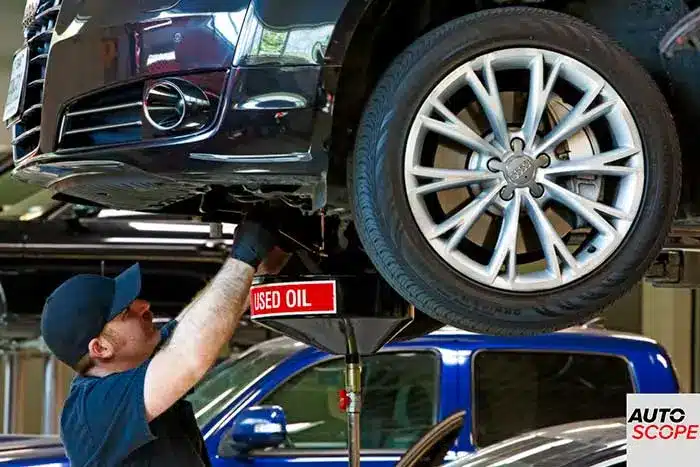Audis are fantastic cars to own, but they’re somewhat expensive to maintain, as is the cost of buying one. According to RepairPal, the average annual maintenance cost across all Audi models is $987 per year – that’s nearly double the national average for all cars. It isn’t surprising when you consider that Audis are luxury cars and require specialty parts, but you might be wondering where that number comes from. Read on as we break down the potential repair and maintenance costs for your Audi vehicle.
Audi Scheduled Service
Audi maintenance costs are based on scheduled service costs and unscheduled repair costs. The first one is simpler to understand – and estimate. Scheduled maintenance is just like it sounds, maintenance that follows a regular schedule.
Audis need two types of scheduled maintenance: minor vehicle maintenance and standard maintenance service. Minor service takes place every 10,000 miles and includes things like an oil and filter change, a brake system check, multi-point inspection, and tire check. The cost for this minor service is around $150-$195. Standard service takes place every 20,000 miles, includes all of the above services plus specific system checks and part replacements if needed, and costs between $525 and $695, according to RepairPal.
While different Audi models may require different maintenance schedules – or cost a bit more/less than the brand average – the below chart can get you a general idea of what a factory-recommended maintenance schedule looks like for an Audi Vehicle. The chart is for an Audi Q5.
Mileage Recommended Service
- 5,000 Rotate Tires (if applicable), Change Oil and Filter
- 15,000 Service Battery/cables, Replace Cabin Replace, Change Oil and Filter
- 25,000 Change Oil and Filter
- 35,000 Lubricate Hood Hinge, Service Battery/cables, Lubricate Trunk, Lubricate Doors hinges and locks,
Cabin Replace Air Filter, Change Oil and Filter - 45,000 Change Oil and Filter
- 55,000 Service Battery/cables, Spark Plugs Replacement (depends on engine size/type)
Replace Cabin Filter, Change Oil and Filter - 65,000 Change Oil and Filter
75,000 Lubricate Hood Hinge, Service Battery/cables, Lubricate Trunk, Lubricate Doors,
Cabin Replace Air Filter, Change Oil and Filter - 85,000 Change Oil and Filter
- 95,000 Service Battery/cables, Cabin Replace Air Filter, Change Oil and Filter
- 105,000 Change Oil and Filter
- 115,000 Replace Air Filter, Lubricate Hood Hinge, Service Battery/cables, Lubricate Trunk
Lubricate Doors, Spark Plugs Replacement, Cabin Replace Air Filter, Change Oil and Filter - 125,000 Change Oil and Filter
- 135,000 Service Battery/cables, Cabin Replace Air Filter, Change Oil and Filter
- 145,000 Change Oil and Filter
Audi Repair Costs
As car owners know too well, it’s not just scheduled services that keep your vehicle on the road. At one point or another, every car will need to head to the mechanic for repairs, and Audis are no different.
Unexpected breakdowns and unwanted fender-benders are incidents no car owner wants to happen, but they do. They’re impossible to predict, but with a bit of guessing, the costs of unplanned repairs can be averaged into your vehicle maintenance cost.
Unfortunately, Audis don’t top the chart for reliability. Of 32 brands considered in a RepairPal reliability survey, Audi ranked 28th most reliable. RepairPal gave the brand a reliability rating of three out of five, as Audi’s tendency to breakdown is higher than the other car brands in the survey. In reality, this is primarily due to the fact that older models are much less reliable, i.e., break down more often, while the newer models are quite reliable. Either way, when comparing the repair expense of different car brands, Audi’s cost is relatively high, as they have unexpected issues at nearly twice the rate of the average vehicle.
While these repair needs aren’t often severe (RepairPal notes that a severe repair is any repair that costs more than three times the average annual repair cost across all models), even common Audi repairs are expensive compared to the average vehicle.
The following chart shows some potential Audi repair needs and their estimated costs.
Service Cost
- AC Compressor Replacement $1,114 – $1,453
- AC Condenser Replacement $675 – $756
- AC Evaporator Replacement $1,569 – $1,736
- AC Receiver Drier Assembly
Replacement $294 – $343 - AC Refrigerant Line Replacement $1,647 – $1,695
- AC Recharge $154-$194
- ABS Control Module Replacement $1,432 – $1,475
- Serpentine Belt Replacement $98 – $124
Audi Extended Warranty Protection
One way to mitigate the cost of repairs on an Audi vehicle is to purchase an extended warranty from an Audi dealer. While all-new Audi vehicles come with a four-year, 50,000-mile warranty, when that warranty expires, Audi owners need to purchase an extended warranty if they want the continued protection for up to ten years or 120,000 miles. These prepaid maintenance plans help by covering all scheduled maintenance costs, while an extended warranty keeps you covered in the event of unexpected breakdowns or need for part replacements.
Although many Audi owners don’t realize it, you can also purchase an extended warranty from an independent auto warranty company. Having a third-party warranty can give you more flexibility over the servicers included and even the contract length. You might be able to get additional benefits such as roadside assistance and rental car reimbursement, and the expense may even be less than the dealer-provided warranty.
Similarly, when comparing repair and maintenance costs, it helps to remember that dealer repair services are often significantly more expensive than independent mechanics. However, no matter where you choose to maintain your Audi, the specialty parts and high-performance service will mean a higher average annual maintenance bill than your run-of-the-mill commuter car.
Fortunately, Audis can last for a long time if they’re properly maintained – upwards of 150,000 miles if you adhere to the regular service schedules. Well-maintained cars have lower maintenance costs, as any potential issues are addressed before they become a real problem. The sooner you develop a routine maintenance schedule for your Audi, the more likely you will have a stress-free car ownership experience.
A Little History of Audi
Audi is one of the best-selling luxury automobile manufacturers in the world. It all started in1899 when August Horch established A. Horch & Cie in Cologne, Germany. In 1909, after moving the company to Zwickau in Saxony and reorganizing it into a joint-stock company, Horch left the company after a dispute with board members. He then established a second automobile manufacturing operation in Zwickau and named it Audi, the Latin translation of the German word “Horch,” which means listen.
In the mid-1920s, automation and assembly lines exploded in American manufacturing. American cars were flooding the European market, which put economic pressure on car manufacturers in Germany. After the Great Depression hit, four Saxony-based car companies merged in 1932 to become Auto Union AG. The companies allying were Audi, DKW, Horch, and the automotive department of Wanderer Werke. Each of the brands was assigned a market segment: DKW – motorcycles and small cars, Wanderer – midsize cars, Audi – deluxe midsize cars, and luxury cars for Horch. (Did you know? The four intertwined rings of the Audi logo represent the four merging companies.)
The last Audi of this era was completed in April 1940 and the Audi name would not return until the 1960s.
During World War II, the Auto Union plants were retooled for military production, which happened to most German manufacturing plants. Because they were making armored cars for the military, they were a target during the war and were severely damaged by allied bombing.
After the war, factories were dismantled as part of the war reparations under the orders of the Soviet military, who controlled East Germany, and Auto Union AG was essentially liquidated.
Executives from the dissolved Auto Union AG relocated to West Germany, where they set up a spare parts operation in Bavaria. This eventually became the headquarters of the reformed Auto Union in 1949, which continued producing front-wheel drive vehicles with two-stroke engines.
In the late fifties, Daimler-Benz briefly owned Auto Nation but sold it to Volkswagen in the early sixties based on a lack of profitability. After relaunching the Audi brand in 1965 with the Audi F103 series, Volkswagen merged Auto Union with NSU Motorenwerke in 1969, creating the present-day form of the company. In 1972, the first-generation Audi 80 was launched.
In the 1980s, Audi introduced the turbocharged Quattro, the world’s first four-wheel-drive sports coupe. The company shortened its name to Audi AG and moved into the luxury market. In 1987, Audi put forth the Audi 90, a more elegant and superior follow-up from the Audi 80. Audi’s release of the V8 was its debut in the upscale market, competing with Mercedes-Benz and BMW.
Internationally known as a prestige brand, Audi is equal to its German counterparts, Mercedes and BMW. Audi vehicles are known for their beautiful design, intelligent state-of-the-art technology, top-of-the-line quality, and performance in every detail.



